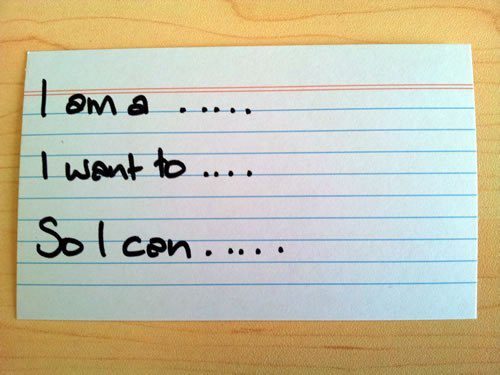User story cards for web writers
User story cards can help you identify your users and their tasks. They're an easy way to do a little planning to help guide your writing.
A simple planning tool
User story cards are simple tools that briefly describe a user, task and goal in 3 statements:
- I am a [user's role]
- I want to [user's task]
- So I can [user's goal].
They're often written on index cards, but you can write them on anything or create them as a Word document.

User story cards have been used to identify requirements in agile projects (a fast, flexible method for developing software). Recently, I read an article suggesting they could be used to help develop content requirements for a website. I think they could also help web writers.
Some examples
I am a year 12 student
I want to find the entry score for the course I'm interested in
So I can decide whether to list it as a preference on my application
I am a local resident
I want to find what Council can do about neighbourhood noise
So I can work out who to contact about a barking dog
Creating user story cards
Who should create them?
Anyone who needs to write web content can create user story cards. If you're a web content manager, you could create some examples to encourage content authors to use them.
How should they be produced?
- Spend a little time thinking about the people who will be using your content. If you're not in a rush you could also:
- Do some brainstorming with a colleague, or better yet, your whole team
- Talk to customer service and your social media team about customer enquiries related to the content you're working on
- Check email enquiries you've received from users
- Ask your web team to provide information about search terms related to your content
- Interview users (if you have the opportunity or budget).
- Think about the tasks users will be trying to do, and why they would be doing them.
- Create a card for each task. If the same task is done by users with vastly different information needs, you might create 2 or 3 cards for a task — one for each type of user. Don't fuss about it too much — this is meant to be a simple tool to help you plan and then write better content. It's not meant to become its own project.
- Try to write the task and goal using words the user would use.
Benefits of user story cards
User story cards can help focus your attention on the:
- People you're writing for (through the role statement)
- Information needs of your audience (through the task and goal statements)
- Keywords your users might search with (through the task statement — if you've managed to write cards in your users' language).
If you try them, I'd love to hear about your experiences with them.
Related links
On user story cards
- User story cards in agile development
- Agile in practice: story cards (video)
- Encouraging content collaboration through user stories
- User need statements